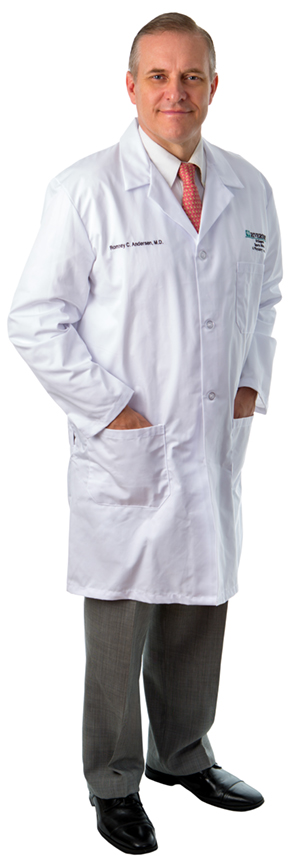COL (Retired), US Army
Orthopaedic Trauma Surgeon,
Riverside Health System at Riverside Regional Medical Center
 The treatment of war wounds is an ancient art, documented as far back as human activities have been recorded. Throughout history, as weapons have become more sophisticated and precise, so the need for more advanced medical practice and technique has expanded. In fact, it’s said that the only good things to come out of war are medical advances.
The treatment of war wounds is an ancient art, documented as far back as human activities have been recorded. Throughout history, as weapons have become more sophisticated and precise, so the need for more advanced medical practice and technique has expanded. In fact, it’s said that the only good things to come out of war are medical advances.
“Certainly looking at WWII, that’s where the development and advancement of hand surgery came from, when so many soldiers came back with mangled extremities,” says Dr. Romney Andersen, who joined Riverside Health System early in 2015. “And ten years from now, the wars in Iraq and Afghanistan will be known for advances in reconstructing severely damaged limbs, advances in treating amputations, and saving lives on the battlefield.”
Dr. Andersen saw many of those advances firsthand, in the combat surgical suites of Operation Just Cause in Panama (1989-90), as Chief of Orthopaedic Surgery at Ibn Sina Hospital and as Theater Consultant for Orthopaedics in Baghdad (2008-09). Most recently, Dr. Andersen served as Chair of Orthopaedics at Walter Reed National Military Medical Center, where he performed more operations on combat casualties than anyone in the US Military.
Following graduation from West Point, he earned his medical degree at the Uniformed Services University of the Health Sciences (USUHS). He served two years in the 1st Infantry Division as a Brigade Surgeon prior to completing his orthopaedic training at Walter Reed Army Medical Center. Following his residency, he completed a fellowship in trauma at the R. Adams Cowley Shock Trauma Center. He served as Director of Orthopaedic Trauma at the National Naval Medical Center, and as Director of Orthopaedic Trauma and Assistant Service Chief at Walter Reed. He holds the academic rank of Professor of Surgery at USUHS, and has over 100 published manuscripts.
It is that highly advanced level of skill, training and experience that Dr. Andersen brings to Riverside Regional Medical Center as one of the orthopaedic trauma surgeons at the Peninsula’s only Level II Trauma Center. “We take care of all the people who come in through Riverside’s Emergency Department,” Dr. Andersen explains. “We see patients with severely injured limbs, whether from auto or motorcycle accidents, and we employ established techniques, as well as newer ones that have been refined on the battlefield, to save those limbs from amputation, and to restore some function.”
While he treats a large number of gunshot wounds, these are generally the result of low velocity firearms, as opposed to the higher velocity weapons of the battlefield. “For many kinds of wounds, including gunshots,” he says, “we can use biologics to help stimulate growth and cure defects within the skin and open wounds that benefit from the newer dressing technologies and pressurized wound therapies.”
Reconstructing limbs remains among the most complicated cases Dr. Andersen treats. He recalls a patient who sustained injury to his bilateral distal femurs, loss of both extensors, and loss of his entire patella on one side. “It took 23 procedures,” he says. “We had to reconstruct his entire quadriceps mechanism, but now he can walk again.”
Even patients with segmental losses to their limbs can be treated, using an old technique refined while treating soldiers injured in Iraq and Afghanistan. “We can lengthen their bones,” Dr. Andersen says. “We know that if we cut a bone and move it very slowly over a long distance, we can regenerate bone.”
Dr. Andersen says “we” almost exclusively, because he emphasizes that caring for severe trauma cases is a team effort, and he is quick to credit the caliber of the subspecialists he works with at Riverside.

